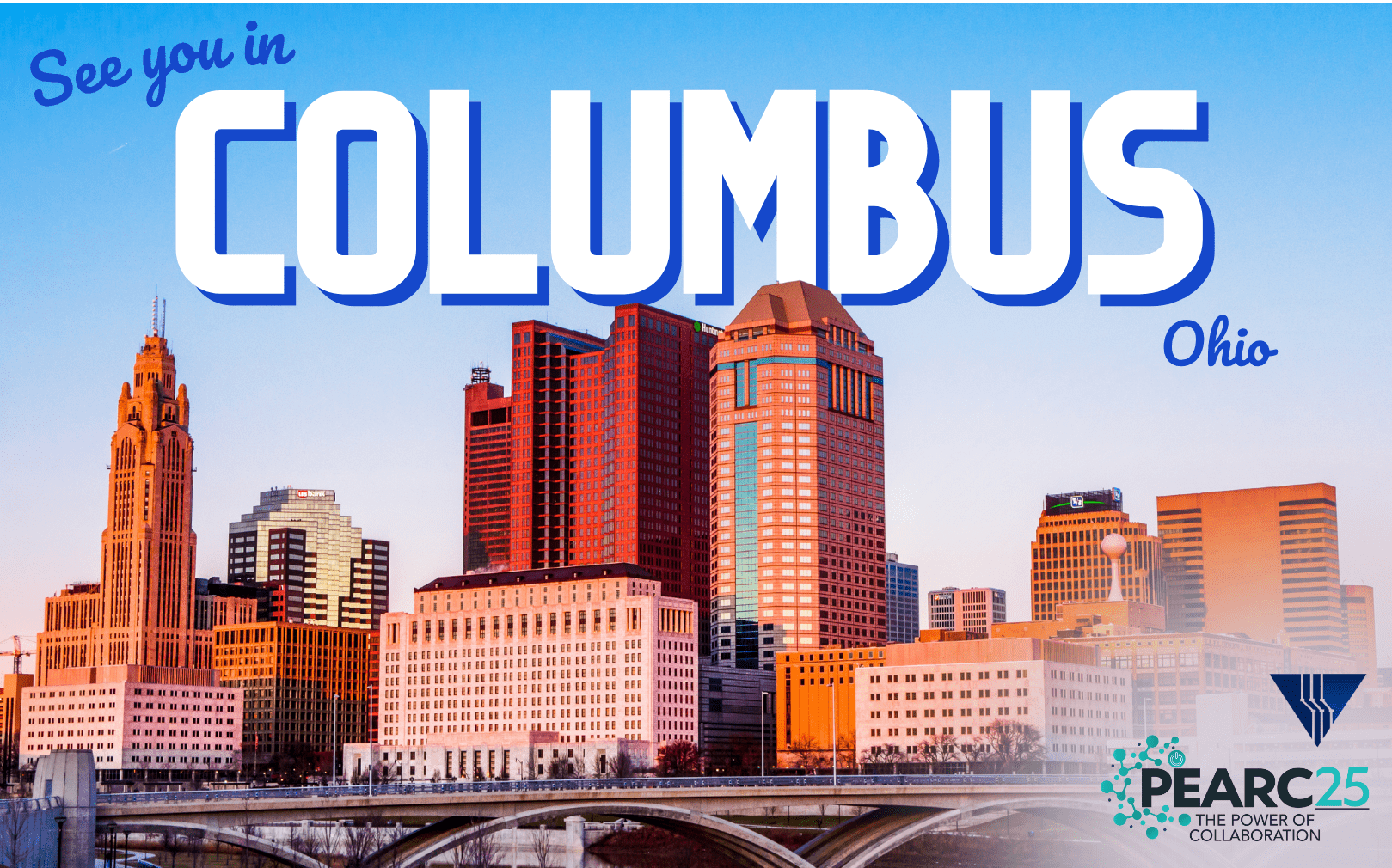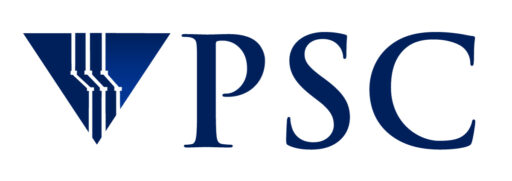
July 20 – 24, 2025
Columbus, Ohio
PSC is pleased to be participating in the PEARC 25 (Practice and Experience in Advanced Research Computing) conference in Columbus, Ohio this year. Come say hello in the exhibit hall! Throughout the conference, PSC staff will contribute via paper presentations, workshops, panel participation, and more.
Monday July 21
9:00 AM – 12:30 PM ET
Half-Day Workshop
Room A214
National Cyberinfrastructure Resources in the Classroom
The “National Cyberinfrastructure Resources in the Classroom” workshop aims to demonstrate the value of leveraging NSF-funded shared cyberinfrastructure resources to enhance the educational experience for both instructors and students. By centralizing computational resources, software, and data, the workshop seeks to lower the technical burden on students and faculty, ensuring a level playing field for all students regardless of their background. Through a mix of informational sessions and demonstrations the workshop will highlight the benefits of using high-performance computing (HPC) and cloud resources such as: with uniform and consistent setups; centralized system and software maintenance; multitenancy; enhanced computational power; zero costs; and data protection. Co-led by the Pittsburgh Supercomputing Center and Indiana University, the workshop will provide participants with practical insights into using these resources for educational purposes, showcasing methods for two distinct platforms with differing capabilities, and provide a venue for rich discussion and recommendations. The workshop is primarily designed for university faculty, teaching assistants, instructors, and IT support staff involved in research computing and data-intensive courses. Participants are expected to have a basic understanding of popular computational tools utilized in classroom settings and an interest in learning how utilizing cyberinfrastructure in their teaching practices will benefit not only themselves but the lives of their students. While prior experience with high-performance computing is beneficial, it is certainly not required, as the workshop will cover foundational concepts and illuminate practical applications and popular use cases.
Authors: Stephen Deems, Jeremy Fischer, Tom Maiden, Julian Pistorius, Zachary Graber and Lena Duplechin Seymour
Stephen Deems, Tom Maiden
9:00 AM – 12:30 PM ET
Half-Day Tutorial
Room A213
A Guideline to Writing a Successful Proposal for ACCESS and Other National Compute Resources
Navigating the ever-changing national landscape of the national computing resources is difficult for any researcher may they be beginners and seasoned long-time users. During our long involvement in the review and allocation process of resources of the NAIRR, ACCESS, leadership-class programs and National Labs (Bridges-2, Expanse, Anvil, Delta, Frontera, Vista, etc) we have helped many scientists to succeed. Our submission at the PEARC25 conference that will address systematically the two most persistent problems that researchers face during the application process. Selecting the appropriate resource among the variety of choices offered and writing a successful application that translates a solid science project into a strong proposal ready to take on the competition.
Authors: Lars Koesterke and Ken Hackworth
Ken Hackworth
9:00 AM – 5:00 PM ET
Full-Day Workshop
Room A112-A113
2nd Workshop on Broadly Accessible Quantum Computing
Building on last year’s success, the 2nd Workshop on Broadly Accessible Quantum Computing at PEARC25 will explore the latest advancements in quantum computing (QC) and its integration with high-performance computing (HPC) and related applications. This year’s edition expands discussions on practical applications, hybrid quantum-classical strategies, and funding opportunities. Through invited talks, panels, and community contributions, we will address workforce development, policy considerations, and strategies for making quantum resources more accessible. Designed for participants of all backgrounds, this workshop fosters collaboration and knowledge exchange to advance QC adoption in the broader research computing community. This workshop is designed for researchers, practitioners, decision-makers, and advanced cyberinfrastructure professionals who are generally interested in understanding the potential of quantum computing beyond its technical intricacies. No prior quantum computing experience is required, making it accessible to a diverse audience. Participants with a basic understanding of classical computing concepts—particularly in HPC, AI, and advanced cyberinfrastructure—will benefit from discussions on the latest advancements, applications, and integration strategies in quantum computing.
Authors: Bruno Abreu, Tommaso Macri, Santiago Nunez-Corrales and Yipeng Huang
Are you working on an exciting quantum computing project and would like to share it with the broader community? We are now accepting submissions for 30-minute oral contributions!
Bruno Abreu
1:30 PM – 5:00 PM ET
Half-Day Workshop
Room A212
How Computational Infrastructures Can Support Scalable AI-Readiness of Data to Power Collaboration
The goal of this workshop is to discuss the synergy between making data AI-ready and the implementation of FAIR principles. Engaging a deep dialogue with the PEARC25 attendees should lead to recommendations for practitioners who develop and utilize scientific and commercial digital ecosystems to advance the creation of trustworthy and productive AI and reusable data infrastructure. These recommendations will be integrated into the stakeholder outreach strategies of the organizing institutions and shared with the advanced computing and data science communities served by the PEARC conference series. Target audience and expected background and/or skill levels. The target audience for this workshop consists of disciplinary researchers and educators, as well as infrastructure developers with an active interest in machine learning and data science. No specific skills or background are expected.
Authors: Sergiu Sanielevici, Laurette Dubé, Christine Kirkpatrick, Raghu Mahiraju, Erik Schultes and Amitava Majumdar
Sergiu Sanielevici
Tuesday July 22
11:00 AM – 12:00 PM ET
Birds of a Feather
OpenHPC Community BoF
OpenHPC provides an open-source, community-driven stack of common ingredients to deploy and manage Linux-based HPC clusters. Formed in November 2015 and formalized as a Linux Foundation project in June 2016, OpenHPC continues to see rapid growth in adoption. It is used by thousands of organizations worldwide, including academic institutes, non-profit organizations, government labs, and commercial entities. At this BOF, speakers from the Technical Steering Committee will provide technical updates and near-term roadmaps. We then invite open discussion, allowing attendees to provide feedback on OpenHPC conventions and packaging, request additional components and configurations, and discuss future trends.
Authors: Christopher Simmons and Derek Simmel
Derek Simmel
11:50 AM – 12:05 PM ET
Workforce Development
ByteBoost: An Advanced Cybertraining Program Designed to Enhance Research on Testbed Systems
The ByteBoost Cybertraining program, funded by the National Science Foundation (NSF), was created to promote the adoption of cutting-edge computing platforms into existing and novel high-performance computing (HPC) workflows. Comprising a team representing three NSF-funded testbed systems: ACES – Texas A&M University, Neocortex – Pittsburgh Supercomputing Center, and Ookami – Stony Brook University; ByteBoost strives to increase utilization and productivity of these technologies across established and emerging HPC-enabled disciplines. To achieve these objectives, ByteBoost invited early career researchers from across the nation to participate in a program consisting of a series of virtual seminars followed by a week-long workshop at the Pittsburgh Supercomputing Center. Over 100 researchers, including students, postdoctoral associates, and early career professors, participated in the ByteBoost cybertraining program. Twenty-four researchers from fourteen institutions were invited to participate in the in-person workshop and successfully incorporated one or more of the represented testbed systems into existing or conceptualized research projects. Participants have since presented their research projects at international conferences, incorporated training into their classes, and continue to utilize the training they received on the testbed systems. We present a broad overview of the inaugural year of ByteBoost Cybertraining program including participant feedback and potential improvements for future iterations.
Authors: Wesley Brashear, Dhruva Chakravorty, Zhenhua He, Dana O’Connor, Eva Siegmann, Paola A. Buitrago and Sergiu Sanielevici
Paola A. Buitrago, Sergiu Sanielevici
Wednesday July 23
2:00 – 3:00 PM ET
Birds of a Feather
Further Conversations from the Ecosystem for Research Networking Summit Series
The Ecosystem for Research Networking (ERN) Summit series provides the research community an opportunity to come together to discuss challenges and opportunities of R1 and non-R1 institutions regarding research collaborations, resource accessibility, regional and national support communities, emerging technologies of AI and quantum, and innovative workforce development programs. The ERN Birds of a Feather (BoF) offers a forum to extend these conversations with the broad spectrum of stakeholders and participants of PEARC’25, where they can share their experiences and thoughts on the topics, learn from other institutions/researchers, and build collaborative contacts. The information gathered here would enhance and augment the Summit’25 findings and recommendations to the research community, funding agencies, and shape ERN future programs and be shared with the research community through ERN’s website.
Authors: Maureen Dougherty, Barr von Oehsen and Forough Ghahramani
Barr von Oehsen
2:00 – 2:15 PM ET
Short Paper
Training a Machine Learned Potential on the Cerebras Wafer Scale Engine
Machine learned potentials, which can achieve the accuracy of \textit{ab-initio} methods at the cost of empirical ones, have become a mainstay of materials simulation. However, training these models often requires large amounts of data and can take several days to train on traditional GPU architectures. With new AI accelerators abound, we train a simple feed forward neural network potential to predict the total energy of a subset of the ANI dataset on GPUs, IPUs, and the Cerebras wafer scale engine (WSE). We examine the effect of the depth of the neural network as well as the batch size on the training time and throughput of the model. We find that the WSE has the fastest training time and the highest throughput across all variables we examined. We also evaluated the throughput per dollar across all variables and accelerators. While the CS-2 has promising performance for these models, the cost for this performance is steep. These results imply that the WSE is a promising hardware for these tasks, though further investigation is needed for the cost/performance tradeoff.
Authors: Dana O’Connor, Wissam Saidi and Paola A. Buitrago
Paola A. Buitrago
2:30 – 2:45 PM ET
Short Paper
Text Representations for Property Prediction of Organic Molecules Using RoBERTa
Recent work has shown that pre-trained large language models (LLMs) and transformers can be used in downstream prediction tasks in materials science and chemistry. Density is often a key property of organic molecules, for example in energetic materials. Transformers rely on text representations of inputs to encode and decode sequences and the choice of text representation may impact model performance on downstream tasks. Here, we pre-train RoBERTa using SMILES, SELFIES, and InCHI text representations on the PubChem10M dataset of organic molecules. We then perform downstream regression training to predict the density of organic molecules. Impact of the regression training dataset size is also examined. We evaluate performance on both a test set of 1000 molecules from the PubChem10M dataset as well as a dataset of energetic materials curated by Elton et al. We find that performance generally increases with increasing regression training dataset size, but that there is much room for improvement. SMILES generally performs the worst of the three descriptors while SELFIES and InCHI perform similarly. Areas of improvement are also discussed.
Authors: Dana O’Connor, Sunny Sun and Paola A. Buitrago
Paola A. Buitrago
2:45 – 3:00 PM ET
Short Paper
Evaluating Pretraining Efficiency of Language Models on AI Accelerators
We explore the deep learning language model use case of general language tasks and chemistry applications and present the benchmark results for various AI accelerators, which is part of the scope of the Open Compass project. The evaluated AI accelerators include NVIDIA V100/A100/H100, AMD 250, and emerging technologies such as Cerebras WSE-2 / WSE-3. Our evaluation focuses on their efficacy in handling diverse deep learning language model training tasks for the Llama/BERT model, with pretraining tasks designed for learning either word prediction or molecular fingerprints through semi-supervised learning. Subsequently, we dive into the key findings gleaned from our trials and offer insights into integrating similar applications with the supercomputing infrastructure.
Authors: Mei-Yu Wang and Paola Buitrago
Mei-Yu Wang, Paola Buitrago
4:15 – 5:15 PM ET
Birds of a Feather
Node to Joy: Finding the Right Compute Resources
In this session, the ACCESS Resource providers (RP) will give a brief overview of the available resources and their unique characteristics. The presentation portion of this BoF will highlight the variety of available resources and will be followed by a discussion with the community, allowing the audience to directly interact with the RP representatives. We hope to seed the discussion with topics but allow attendees to steer the discussion, perhaps uncovering topics not suggested here.
Authors: Jeremy Fischer, Carol X. Song, Eva Siegmann, Sergiu Sanielevici, Honggao Liu, Virginia Trueheart and Jim Griffioen
Sergiu Sanielevici
Posters will be displayed all conference long, in addition to the Wednesday Poster Reception.
5:30 PM – 7:30 PM ET
Poster
Architecture for Collaboration: Building a Unified ACCESS Resource Catalog
One of the key challenges during the early years of the ACCESS program was the lack of a comprehensive online catalog for selecting advanced computing resources. Researchers and educators had to visit a variety of separate web pages to find information about the resources, such as hardware specifications, software availability, training opportunities, system status, and wait time metrics. | Developed over seven months during 2024, the resource catalog is a collaborative effort to bring together information about resources from across the ACCESS ecosystem. It provides a one-stop online destination for researchers and educators to learn about and select resources. In this poster, I describe how the design and technical choices we made during the development of the catalog enabled the ACCESS teams to work together in new ways and set the stage for future collaboration.
Authors: Matt Yoder
Matt Yoder

